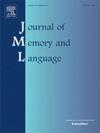Planning competing values of a single phonological feature vs. planning values for multiple features
IF 3
1区 心理学
Q1 LINGUISTICS
引用次数: 0
Abstract
We tested the hypothesis that phonological planning takes longer when two possible utterances differ in incompatible, inherently mutually exclusive values of a single feature (e.g., voiced vs. unvoiced, a dental vs. alveolar tongue-tip constriction) compared to when two possible utterances differ in values for features that are not inherently mutually exclusive (e.g., a tongue-tip constriction vs. a labial constriction). Verbal acoustic latencies from a cue-response task were analyzed. When the mutually exclusive feature value was voicing in plosive-intial utterances, latencies were in fact shorter than when articulator was unknown, contra expectation. When the mutually exclusive feature value was voicing in fricative-intial utterances, there was no reliable difference in latencies. When the mutually exclusive feature value was tongue-tip constriction location, latency differences were as expected, albeit marginally. These results suggest that the notion of inherently mutually exclusive feature values requires further refinement, and may depend on specific aspects of phonological representation.
规划单个语音特征的竞争值与规划多个特征的价值
我们测试了这样一个假设,即当两个可能的话语在一个单一特征的不相容的、内在互斥的值上不同时(例如,浊音与不浊音,牙齿与肺泡舌尖收缩),语音规划所需的时间要比两个可能的话语在本质上不互斥的特征的值上不同时(例如,舌尖收缩与唇部收缩)花费的时间更长。分析了线索反应任务的言语声潜伏期。当互斥特征值在爆发性初始话语中发声时,潜伏期实际上比发音者未知时短,这与预期相反。当互斥特征值为摩擦音起音时,潜伏期无可靠差异。当互斥特征值为舌尖收缩位置时,潜伏期差异与预期一致,尽管差异不大。这些结果表明,内在互斥特征值的概念需要进一步完善,并且可能取决于语音表示的特定方面。
本文章由计算机程序翻译,如有差异,请以英文原文为准。
求助全文
约1分钟内获得全文
求助全文
来源期刊
CiteScore
8.70
自引率
14.00%
发文量
49
审稿时长
12.7 weeks
期刊介绍:
Articles in the Journal of Memory and Language contribute to the formulation of scientific issues and theories in the areas of memory, language comprehension and production, and cognitive processes. Special emphasis is given to research articles that provide new theoretical insights based on a carefully laid empirical foundation. The journal generally favors articles that provide multiple experiments. In addition, significant theoretical papers without new experimental findings may be published.
The Journal of Memory and Language is a valuable tool for cognitive scientists, including psychologists, linguists, and others interested in memory and learning, language, reading, and speech.
Research Areas include:
• Topics that illuminate aspects of memory or language processing
• Linguistics
• Neuropsychology.

 求助内容:
求助内容: 应助结果提醒方式:
应助结果提醒方式:


